Linkbuilding
Het verkrijgen van een goede organische zichtbaarheid binnen zoekmachines begint bij het optimaliseren van de eigen website. Zoals technische optimalisaties aan de website die het zo gemakkelijk mogelijk maken voor zoekmachine ‘spiders’ om de website te betreden en zo efficiënt mogelijk te doorlopen en indexeren. Naast het doorvoeren van technische optimalisaties is het cruciaal om de website te voorzien van pakkende, tekstuele en visuele content om de organische zichtbaarheid te optimaliseren, maar uiteraard voornamelijk om de behoefte van de zoekmachine gebruiker te vervullen.
Des te hoger de organische positie een website heeft, des te hoger de CTR (Click Through Rate) is van zoekmachine gebruikers. Dit wil zeggen het aantal gebruikers dat doorklikt naar de website vanuit een zoekmachine. Plat gezegd betekent dit: hoe hoger je in zoekmachines staat, hoe meer verkeer je binnenhaalt. Het behalen van een zo hoog mogelijke positie op je belangrijkste zoekwoorden is dus cruciaal. Maar als de content en techniek van een domein al volledig geoptimaliseerd is, maar je hebt nog geen top posities behaald, hoe kun je dan toch deze posities nog verder optimaliseren? Een derde mogelijkheid is door het optimaliseren van de autoriteit van een domein, oftewel linkbuilding.
jouw kunnen doen?
Wat is linkbuilding
Linkbuilding is een proces waarbij backlinks worden gegenereerd vanaf (voornamelijk externe) websites naar een specifiek domein. Het doel achter de techniek ‘linkbuilding’ is om (een deel van) de autoriteit van een extern domein over te brengen naar het ontvangende domein. De links van externe domeinen dienen als ondersteuning voor de geloofwaardigheid en betrouwbaarheid van de content van jouw eigen website. Dit is exact wat je wilt bereiken met je website of webshop. Wanneer externe websites een backlink plaatsen naar de content op jouw website, dan dient dit ter ondersteuning van de informatie die specifiek gedeeld wordt rondom een onderwerp. Zoekmachines zullen deze autoriteit herkennen en hiermee een hogere relevantie toekennen aan jouw website of pagina. Dit alles zal leiden tot betere organische posities.
Wat is een backlink?
Een backlink is een hyperlink welke afkomstig is van een extern domein. De backlink verwijst dus op een specifiek domein, middels een hyperlink, naar een ander domein.
Voorbeeld: LEQUAL ontvangt een backlink van Wikipedia. Dit betekent dat Wikipedia ergens op haar website, middels een hyperlink, verwijst naar het domein lequal.com.

Hoe vergaar je backlinks?
Linkbuilding is het proces waarmee je als organisatie relevante backlinks probeert te vergaren bij relevante externe domeinen om zo je organische zichtbaarheid te verbeteren. Hoe zorg je er echter voor dat externe partijen een hyperlink willen plaatsen naar jouw website? Hier zijn verschillende manieren voor.
Organische verkrijgen, oftewel link earning
Het ultieme scenario om autoriteit op te bouwen is door het verkrijgen van backlinks op een organische manier. Dit houdt in dat externe websites de content op jouw website van meerwaarde vinden en hierdoor willen verwijzen naar deze content, bijvoorbeeld als bronvermelding. Dit is ook de reden dat informatieve partijen zoals grote nieuwswebsites organisch enorm veel backlinks verkrijgen (link earning) en hiermee een enorme autoriteit opbouwen. Echter, dit is voor commerciële partijen, met een minder interessante niche, lastiger te bereiken. Dit houdt echter niet in dat er geen mogelijkheden zijn.
Backlinks kopen
De snelste en meest eenvoudige manier om aan kwalitatieve backlinks te komen is het inkopen van verwijzingen op externe domeinen. Dit is wereldwijd één van de meest gebruikte technieken voor het opbouwen van autoriteit. Veel content publishing websites, zoals blogs en nieuwswebsites, hebben een verdienmodel opgezet waarbij er verwijzingen (backlinks) worden verkocht in een gepubliceerd artikel of blog waarbij er een bedrag betaald wordt door de ontvangende partij. De content hoeft dus niet zozeer van meerwaarde te zijn voor een publicerende partij, want er wordt een bedrag betaald.
Deze vorm van het verkrijgen van backlinks wordt door zoekmachines zoals Google niet getolereerd. Oftewel het opzettelijk manipuleren van de algoritmes van zoekmachines kan leiden tot penalty’s vanuit zoekmachines waarbij de organische zichtbaarheid van de ontvangende partij sterk verminderd kan worden. Echter, we zien in de praktijk dat veel organisaties in competitieve markten gebruik maken van deze techniek en de mogelijke straffen niet schromen.
Backlinks realiseren via je omgeving
Naast het inkopen van backlinks, of het organisch verkrijgen van backlinks, zijn er nog andere mogelijkheden die veelal gratis gerealiseerd kunnen worden. Bijvoorbeeld door handig gebruik te maken van de omgeving van je organisatie. Organisaties hebben doorgaans veel partners, leveranciers en afnemers. Dit partnerschap kun je bevestigen middels een verwijzing.
Om de kansen in kaart te brengen is het raadzaam om jouw organisatie in kaart te brengen. Welke partners heb je op het vlak van ICT, development en hosting? Maak daarnaast ook inzichtelijk van welke tools je gebruikmaakt tot aan wie de koffiebonen leveren. Zo kun je aanbieden een testimonial te schrijven voor de betreffende partij om hiermee een backlink te genereren. Dergelijke backlinks zijn zeer relevant gezien de samenwerking tussen de partijen. Tevens zijn deze backlinks zeer lastig te kopiëren voor concurrenten wanneer zij deze samenwerkingen niet hebben met dezelfde partijen.
PR (linkbuilding)
Middels PR linkbuilding is het mogelijk om backlinks te verkrijgen van de meest autoritaire domeinen. PR linkbuilding is een zeer creatieve en duurzame strategie om backlinks te vergaren. Echter is deze strategie niet voor elk type organisatie weggelegd. De trajecten zijn veelal erg kostbaar en intensief. Echter kunnen succesvolle PR campagnes wel het verschil maken voor een krachtig backlinkprofiel.
Maar hoe gaat dit precies in zijn werk? PR linkbuilding campagnes beginnen doorgaans met het opstellen van een aantal interessante stellingen. Stellingen die nieuwswaardig zijn, of stellingen die doorgaans voor veel discussie en/of ophef zorgen. Vervolgens worden deze stellingen getoetst bij een onderzoekspanel. De uitkomsten worden gedeeld middels een concluderend persbericht. Tot slot wordt dit persbericht verspreid onder de landelijke media. Of het bericht ook daadwerkelijk wordt overgenomen is vaak een vraagteken, maar goede connecties bij redacties verhogen doorgaans de slagingskans.
Belangrijke aandachtspunten bij linkbuilding
Relevantie van backlinks
De relevantie van de backlinks is een enorm belangrijke factor bij linkbuilding. Dit houdt in dat de backlink afkomstig is van een domein waarbij het onderwerp van het domein en de inhoud overeenkomt met het onderwerp of de niche van het ontvangende domein. Ook kun je de relevantie van de backlink verhogen door de backlink in de juiste context te plaatsen.
Natuurlijkheid en autoriteit van externe domeinen
De techniek linkbuilding is in de afgelopen jaren enorm geïnnoveerd. Algoritmes worden steeds geavanceerder en detecteren opvallende manipulatietechnieken steeds gemakkelijker. Een natuurlijk en duurzaam backlinkprofiel is dus een vereiste om langdurig profijt te hebben van de linkbuilding-inspanningen. Naast de relevantie van het domein is het belangrijk dat een extern domein waarvan je een backlink wenst te ontvangen ook relevant verkeer ontvangt. Is het domein relevant en ontvangt het domein zelf relevante bezoekers middels kwalitatieve content? Dan is een backlink van dit domein hoogstwaarschijnlijk een goede aanwinst voor jouw backlinkprofiel!
Relevantie en natuurlijkheid van potentiële backlinks is dus belangrijk, maar zijn er dan nog meer factoren die van belang zijn als je kijkt naar ‘de ideale backlink’? Een derde belangrijke factor is de autoriteit van het domein waarvan je een backlink ontvangt. Des te hoger de autoriteit van dat domein, des te krachtiger de link. Maar hoe meet je de autoriteit van een extern domein? De autoriteit van een extern domein meet je middels Third Party tools zoals Majestic, Ahrefs, MOZ en SemRush. Al deze tools beschikken over hun eigen metrics gebaseerd op een eigen algoritme. De tools geven een indicatie over de autoriteit van een domein. In hoeverre deze indicatie overeenkomt met de algoritmes van zoekmachines zoals Google is niet inzichtelijk. De indicatie is echter wel bruikbaar om te bepalen hoe waardevol een backlink is van een extern domein. Staar je echter niet blind op dergelijke metrics van Third Party tools.
Link Velocity
Link velocity, oftewel de snelheid waarmee je backlinks backlinks vergaard, wordt over het algemeen gebaseerd op het aantal backlinks dat van maand tot maand binnenkomt. In hoeverre link velocity een rol speelt in de organische posities is onbekend. Wat we echter wel merken is dat een stagnatie of daling in de binnenkomende links over het algemeen leidt tot dalende organische posities. Hierdoor wordt er doorgaans geadviseerd om een stabiele stroom aan binnenkomende backlinks te realiseren en hiermee momentum te creëren.
Anchorteksten
Anchorteksten, ook wel linkteksten of ankerteksten genoemd, is de tekst waarachter de hyperlink gekoppeld zit. Bij het plaatsen van backlinks op externe domeinen dien je dus rekening te houden met de anchortekst waarachter de backlink geplaatst wordt. Zoekmachines zijn in staat om de anchortekst te lezen en dus geeft deze anchortekst aan zoekmachines een indicatie wat er te vinden is op de pagina waar de backlink heen leidt. Echter, het gebruik van te veel van dezelfde anchorteksten kan leiden tot over-optimalisatie.
Homepage- versus deeplinks
De focus van een linkbuilding campagne is een belangrijk onderdeel van de voorbereiding. Welke zoekwoorden zijn kansrijk en commercieel gezien interessant? Mogelijk ben je op deze zoekwoorden zichtbaar op je homepage, maar er is een grote kans dat je zichtbaar bent met een dieperliggende pagina. Wanneer dit het geval is dan loop je het risico op ‘scheefgroei’ wanneer de volledige linkbuilding campagne op de dieperliggende pagina’s gericht wordt. Bij een natuurlijk backlinkprofiel ontvangt de homepage ongeveer 20% van alle inkomende backlinks, de overige backlinks worden enigszins evenredig verdeeld over de overige dieperliggende pagina’s. Voorkom scheefgroei door de backlinks te verspreiden over de landingspagina’s en de homepage.
Creatieve linkbuilding strategieën
Creativiteit speelt een cruciale rol in de linkbuilding strategie. Hoe creatiever de campagne, hoe unieker de backlinks en dit maakt het lastig voor de concurrentie om deze backlinks na te bootsen.
Middels creativiteit kun je uitlopen op de concurrentie en jouw backlinkprofiel echt uniek maken ten opzichte van de concurrentie. Maar welke creatieve linkbuilding strategieën zijn er nu allemaal precies? Wij hebben ze in de naastgelegen afbeelding op een rijtje gezet.

Kennisdeling
Kennisdeling is een zeer creatieve strategie om backlinks te genereren, maar tevens ook om exposure te creëren. Beschik je over veel kennis over een specifiek onderwerp? Dan ben je van meerwaarde voor externe kennisplatformen. Middels deze strategie ga je op zoek naar informatieve platformen die openstaan voor een samenwerking waarbij je gratis kennis deelt in ruil voor exposure voor je bedrijf, met bij voorkeur een backlink meegenomen in deze samenwerkingen. Dergelijke samenwerkingen zijn over het algemeen gunstig voor beide partijen. Naast de exposure en backlink werk je ook aan autoriteit op persoonsniveau en zullen zoekmachines de content die je publiceert op verschillende platformen sneller als autoritair aanmerken.
Barterdeals
Geen budget voor het ‘kopen’ van backlinks en het betalen van samenwerkingen? Gelukkig leiden er meerdere wegen naar Rome. Met behulp van barterdeals kun je relevante producten of diensten weggeven aan platformen in ruil voor een blogpost. De slagingskans op een samenwerking is doorgaans iets lager dan wanneer er geld betaald wordt, echter is een barterdeal voor een merk doorgaans goedkoper dan het betalen in cash. Ook kan een barterdeal leiden tot exposure en eventueel sales wanneer er bijvoorbeeld een weggeefactie of kortingscode wordt gedeeld in de samenwerking.
Branded citations
Grote merken en bedrijven worden over het algemeen veel benoemd in de media, voornamelijk wanneer de PR-afdeling actief is. Branded citations zijn vermeldingen van een merk of bedrijf op externe websites. Veelal zien we dat branded citations geen backlinks bevatten, dit terwijl er wel over een bedrijf geschreven wordt. Het kan lonen om met behulp van de PR-afdeling contact op te nemen met publicerende platformen om de backlink toe te voegen aan de citation. Dit is een erg laagdrempelige en zeer effectieve strategie, maar over het algemeen wel enkel geschikt voor grotere organisaties.
Skyscrapers
De skyscraper techniek is een strategie waarbij zeer uitgebreide, informatieve content op de eigen website gepubliceerd wordt. Hierbij wordt er inspiratie vergaard van externe bronnen (concurrenten) en is het doel om de content in de basis in eigen bewoording te kopiëren, maar vervolgens beter en uitgebreider te maken. Met deze complete informatie benader je externe platformen die hier ook over hebben geschreven met het verzoek om naar de skyscraper te linken. De content moet echter wel van dermate goede kwaliteit en toegevoegde waarde zijn dat een eventuele link waardevol is voor externe domeinen. Bij de skyscraper techniek is het van belang dat de content zo veel mogelijk geüpdatet wordt en zo compleet en origineel mogelijk is.
Een linkbuilding campagne begint met een nauwkeurige 0-meting. Breng alle relevante termen zo nauwkeurig mogelijk in kaart en maak hier een 0-meting van de posities. Noteer duidelijk de posities en data of maak gebruik van een dashboard met de mogelijkheid tot het tracken van posities. Wanneer gewenst kun je ook andere belangrijke data tracken na een 0-meting zoals verkeer per pagina of domeinbreed, autoriteit metrics, aantal verwijzende domeinen en backlinks etc. Echter, veel van deze data is ook met terugwerkende kracht te bekijken in ondersteunende SEO-tools.
Een concurrentieanalyse is een mooi hulpmiddel om de strategie van de concurrentie te achterhalen en hier van te leren. Enkele zaken die aan bod komen in de concurrentieanalyse zijn onder andere:
- – Huidige posities en positie ontwikkeling van de concurrentie
– Benchmarking metrics ten opzichte van de concurrentie
– Deep-dive: welke strategie hanteert de concurrentie?
– Welke backlinks heeft de concurrentie gegenereerd?
– Hoe ziet het anchor profiel van de concurrentie eruit?Op basis van de bovenstaande inzichten kan de eigen strategie worden bijgeschaafd. Ook geeft het mogelijk inzichten voor interessante backlinks die na te bootsen zijn.
Wanneer de 0-meting en de concurrentieanalyse gemaakt zijn, is het tijd om de definitieve strategie uit te werken. Het is nu immers duidelijk welke zoekwoorden interessant zijn, wat je wellicht nog tekort komt ten opzichte van de concurrentie en welke strategie de concurrentie hanteert. Op basis hiervan kan de linkbuilding strategie gebaseerd worden. Hoeveel linkbuilding-inspanningen zijn er nodig, welke linkbuilding techniek ga je gebruiken, hoe ga je de anchorteksten inrichten en op welke pagina’s ga je de focus leggen? Wanneer dit alles helder is, kan de strategie geformuleerd worden.
Meten en bijsturen is een onderdeel dat nog regelmatig onderschat wordt. Echter, het meten van resultaat is zeer belangrijk. Door resultaat te meten kun je inschatten hoeveel inspanning er nog nodig is om bepaalde resultaten te behalen, en zoals we weten kan het verschil in CTR enorm zijn wanneer je bijvoorbeeld van positie 2 naar positie 1 stijgt. Wanneer je het maximale resultaat hebt behaald, kun je van strategie wisselen. Stijgen is namelijk niet meer het doel en dus kun je mogelijk wisselen naar de strategie ‘behouden’. Dit zorgt ervoor dat je budget en inspanningen kunt veranderen naar nieuwe categorieën.